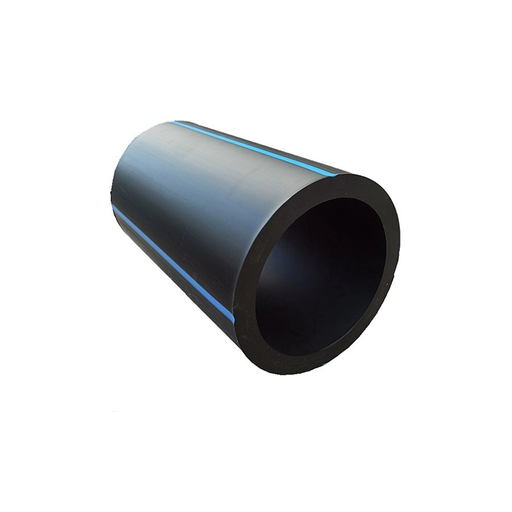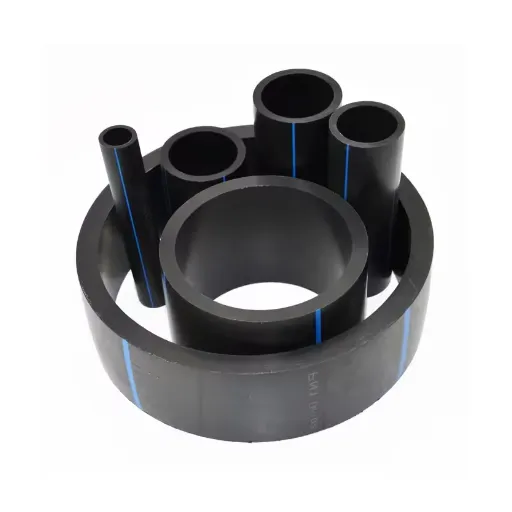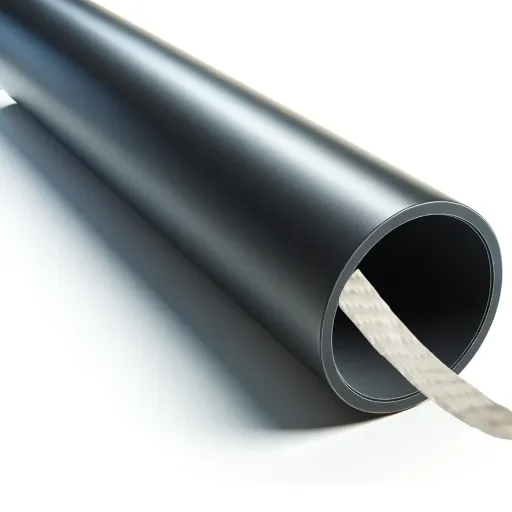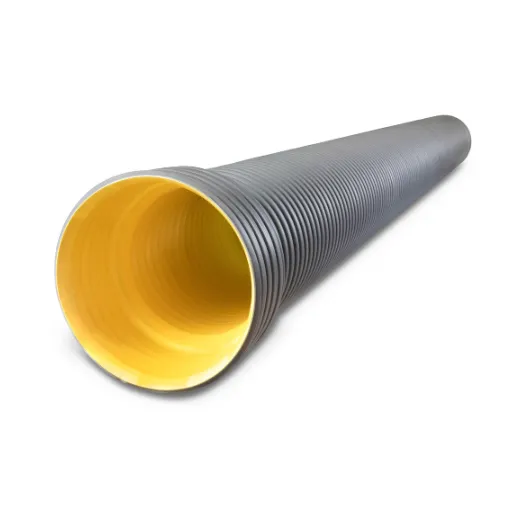Applications of Large Diameter HDPE Pipes

Water Supply and Distribution
HDPE pipes for water supply and distribution have always been favorites in harsh working environments due to their highly durable nature. Key advantages include:
- Corrosion Resistance: Unlike conventional counterparts, HDPE pipes resist corrosion, ensuring water is carried without contamination
- Flexible Nature: Can resist environmental pressures like ground movement, temperature variation, and heavy loads
- Hydraulic Excellence: Lower electricity costs due to reduced frictional losses during water conveyance
- Cost-Effective Lifecycle: Minimal maintenance requirements with a lifespan of 50 to 100 years
- Easy Installation: Reduces project costs and timelines
Oil and Gas Industry Applications
Polyethylene pipes find wide application in the oil and gas industry for their exceptional performance characteristics:
| Feature | Benefit | Application |
|---|---|---|
| Corrosion Resistance | Long-term durability | Natural gas transport |
| Chemical Resistance | Handles harsh substances | Petrochemical transport |
| Temperature Resistance | Performs in extreme conditions | Onshore/offshore applications |
| Lightweight Design | Easy installation and transport | Remote locations |
| Fusion Welding | Leak-proof joints | Safety-critical systems |
Mining and Infrastructure Development
Mining plays an essential part in infrastructure development by providing raw materials needed for construction. The relationship between mining and HDPE pipes includes:
- Material Supply: Minerals like iron, copper, and aluminum for structural components
- Aggregate Production: Sand and gravel for concrete and asphalt
- Sustainable Practices: Environmentally friendly technologies and waste reduction
- Advanced Techniques: Automated machinery and digital monitoring systems
Benefits of Using Large-Diameter HDPE Pipes
Durability and Reliability
Large-diameter HDPE pipes are renowned for their ability to withstand heavy stresses and environmental attacks, including extreme temperatures, corrosive chemicals, and mechanical impacts.
Critical durability features include:
- Non-Corrosive Properties: Longer lifespan compared to steel or concrete
- Extreme Flexibility: Can absorb loads without cracking
- Seismic Resistance: Particularly useful in earthquake-prone areas
- Heat Fusion Joints: Create leak-proof, reliable seals
- Sustainable Choice: Minimize transportation and installation costs
Flexibility and Cost-Effectiveness
The outstanding flexibility of large-diameter HDPE pipes provides multiple advantages:
| Aspect | Traditional Materials | HDPE Pipes |
|---|---|---|
| Ground Movement Response | Crack or fail | Accommodate without damage |
| Installation Complexity | Heavy equipment required | Lightweight, minimal equipment |
| Lifecycle Cost | Higher maintenance | 30-50% lower costs |
| Terrain Adaptability | Limited flexibility | Suitable for varied terrains |
Environmental Impact and Sustainability
HDPE pipes offer significant environmental advantages:
- Longer Lifecycle: Fewer replacements needed, reducing manufacturing impact
- Recyclability: Can be recycled back into the original manufacturing process
- Lower Carbon Emissions: Production generates fewer emissions than steel or concrete
- Energy Efficiency: Lightweight design reduces transportation energy
- Resource Conservation: Leak-proof systems prevent waste of transported resources
Manufacturing Process of HDPE Pipes

Materials Used in HDPE Pipe Production
The manufacturing process relies on carefully selected materials:
- Polyethylene Resin: The Main raw material determining strength, flexibility, and durability
- Additives and Stabilizers: UV resistance, heat stabilization, and chemical degradation resistance
- Thermal Stabilizers: Enable pipes to endure various temperature ranges
- Antioxidants: Ensure a long lifespan by preventing oxygen damage
- Pigments: Particularly carbon black for UV protection
- Recycled Polyethylene: Incorporated for sustainability and cost reduction
Technologies Involved in Manufacturing
Advanced manufacturing technologies ensure precision and quality:
| Technology | Function | Quality Benefit |
|---|---|---|
| Extrusion Process | Melts and forms HDPE through controlled dies | Uniform diameter and wall thickness |
| Automated Monitoring | Real-time corrections during production | Maintains the highest accuracy |
| Advanced Cooling Systems | Rapid solidification post-extrusion | Smooth surfaces and structural integrity |
| Ultrasonic Testing | Non-destructive defect detection | Ensures industry standard compliance |
Installation Best Practices for Large Diameter HDPE Pipes
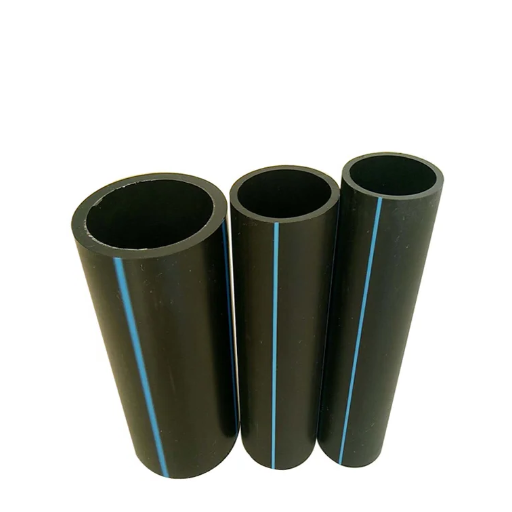
Preparation and Planning for Installation
Successful installation requires comprehensive preparation:
- Site Assessment: Evaluate terrain challenges and obstructions
- Equipment Preparation: Ensure adequate tools and equipment availability
- Permit Acquisition: Obtain all necessary regulatory approvals
- Specification Review: Verify pressure ratings, diameter, and length requirements
- Team Communication: Establish clear safety practices and execution programs
- Quality Inspection: Complete inspection of pipes and fittings before installation
Methods of Installation: Butt Fusion and Others
- Butt Fusion:
- The most common method for thermoplastic pipes
- Heats the pipe ends to the melting temperature
- Creates leak-proof, durable connections
- Requires proper alignment and temperature control
- Electrofusion Welding:
- Uses special fittings with electrical resistance heaters
- Ideal for confined or remote areas
- Provides versatile and precise connections
- Horizontal Directional Drilling:
- Minimal environmental disruption
- Useful in urban areas where excavation isn’t feasible
- Efficient for water main installations
Ensuring Safety and Efficiency During Installation
Safety and efficiency protocols include:
- Component Inspection: Verify compliance with quality standards
- Personnel Training: Ensure skilled implementation of joining techniques
- Environmental Planning: Mitigate soil movement, temperature variation, and corrosive agents
- Safety Practices: Proper equipment handling, PPE usage, and regulation compliance
- Testing Procedures: Regular checks during and after installation
Maintenance Tips for Large Diameter HDPE Pipes

Regular Inspection and Monitoring
Effective maintenance requires systematic monitoring:
| Inspection Type | Method | Purpose | Frequency |
|---|---|---|---|
| Visual Inspection | External observation | Detect cracks, deformations | Monthly |
| Ultrasonic Testing | Non-invasive thickness measurement | Internal damage assessment | Annually |
| Flow Analysis | Sensor monitoring | Pressure, temperature, and flow rates | Continuous |
| Data Logging | Comprehensive record keeping | Trend analysis and planning | Ongoing |
Cleaning and Maintenance Strategies
Comprehensive maintenance strategies include:
- High-Pressure Water Blasting (Hydro-jetting):
- Removes debris, scale, and blockages
- Restores optimal working conditions
- Prevents long-term sediment damage
- Mechanical Cleaning Methods:
- Utilizes pigs and scrapers
- Effective for surface contamination removal
- Chemical Cleaning Solutions:
- Addresses persistent contaminants like grease or minerals
- Maintains functionality without material damage
- Advanced Inspection Technologies:
- Video pipe inspection technology
- Real-time internal condition data
- Early problem detection capabilities
Frequently Asked Questions (FAQ)
Q: What is a large diameter HDPE pipe?
A: A large diameter HDPE pipe is a high-density polyethylene pipe designed for various applications, including water supply, drainage, and utility services. These pipes are renowned for corrosion resistance, durability, and reliability, making them ideal for large-scale projects like water transmission mains.
Q: What are the applications of large-diameter HDPE pipe?
A: Leading applications include municipal water supply, drainage systems, and industrial piping solutions. These pipes excel in high-flow situations and water main applications due to their ability to resist great pressures and high flow rates.
Q: How durable and reliable are large-diameter HDPE pipes compared to other materials?
A: Large diameter HDPE pipes top the chart in durability and dependability compared to traditional materials like PVC and concrete. With high-impact resistance and seismic activity withstanding properties, HDPE pipes are ideal for critical water supply and drainage systems.
Q: What importance does proper fusion hold in HDPE pipe installation?
A: Proper fusion is paramount as it ensures joints are sound and leak-free. Common fusion methods include butt fusion and fusible joints, which provide the strength and durability required for reliable pipeline performance.
Q: Can large-diameter HDPE pipes be used for water main applications?
A: Yes, large diameter HDPE pipes are excellent for water main operations. These pipes can handle water supply across long distances and withstand typical pressures in municipal water systems.
Q: Are there cost savings when using HDPE for large diameter pipe installation?
A: Yes, HDPE offers significant cost savings due to its lightweight nature, reducing transport and installation time. The longevity and low maintenance requirements of HDPE pipes provide additional long-term cost benefits.
Q: What are the benefits of PE 100 materials in large diameter HDPE pipes?
A: PE100 materials exhibit greater resistance and flexibility, making them ideal for large-diameter HDPE pipes. This material can handle higher pressures and meets ASTM and ISO standards for quality assurance and performance in various environments.
Q: How does horizontal directional drilling affect large diameter HDPE pipe installation?
A: Horizontal directional drilling allows installation with minimal environmental disruption. This method is particularly useful in urban areas where excavation might not be feasible for water main installations.
References
- ASCE Library: Case studies on the use of HDPE pipe in municipal and industrial projects in North America – Comprehensive study on HDPE pipes for water resources management
- MDPI: A study on the mechanical responses of plastic pipes made of high-density polyethylene HDPE in water supply networks – Research on mechanical behavior and environmental advantages
- ScienceDirect: An overview of long-term testing methods for HDPE pipe – pros and cons – Review of evaluation methods for life and serviceability assessment
- ASTM Digital Library: Analysis of large diameter high-density polyethylene plastic pipes as vertical shafts in landfills – Structural performance analysis for specialized applications
- ResearchGate: Study on Determination of Quality Characteristic and Performance of High-Density Polyethylene Pipes in Selangor Water Applications – Quality and performance evaluation research



